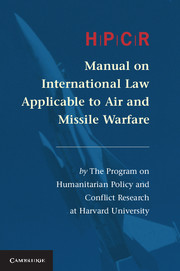Book contents
- Frontmatter
- Contents
- Foreword
- Introduction
- Black-Letter Rules of the HPCR Manual on International Law Applicable to Air and Missile Warfare
- Commentary to the HPCR Manual on International Law Applicable to Air and Missile Warfare
- Appendix I Group of Experts
- Appendix II Sessions of the Group of Experts
- Appendix III List of Informal Meetings with State Representatives
- Appendix IV Drafting Committee: Members & Meetings
- Appendix V Table of Treaties (Chronological)
- Appendix VI Table of Abbreviations
- Index
Commentary to the HPCR Manual on International Law Applicable to Air and Missile Warfare
Elaborated by the Drafting Committee of the Group of Experts under the supervision of Professor Yoram Dinstein.
Published online by Cambridge University Press: 05 July 2013
- Frontmatter
- Contents
- Foreword
- Introduction
- Black-Letter Rules of the HPCR Manual on International Law Applicable to Air and Missile Warfare
- Commentary to the HPCR Manual on International Law Applicable to Air and Missile Warfare
- Appendix I Group of Experts
- Appendix II Sessions of the Group of Experts
- Appendix III List of Informal Meetings with State Representatives
- Appendix IV Drafting Committee: Members & Meetings
- Appendix V Table of Treaties (Chronological)
- Appendix VI Table of Abbreviations
- Index
Summary
For the purposes of this Manual -
The definitions in this Section of the Manual were drafted by the Group of Experts. When they reflect a treaty text, the Commentary will quote that source, or at least cite it.
Definitions have to be read in the context of the Black-letter Rules appearing in the substantive Sections of this Manual. Generally speaking, it is in that context that the question whether the definition is applicable to non-international armed conflicts has to be addressed. Clearly, some definitions – e.g., Neutral (see Rule 1 (aa)) – have no bearing upon non-international armed conflict (this will be so indicated in the respective Commentary on the relevant substantive Black-letter Rules).
On the other hand, it is necessary to take into account provisions such as Art. 2 (6) of the 1996 Amended Protocol II to the CCW and Art. 1 (f) of the Second Protocol to the 1954 Hague Convention. Both the 1996 Amended Protocol II to the CCW and the Second Protocol to the 1954 Hague Convention now apply both in international and non-international armed conflict.
(a) “Air” or “airspace” means the air up to the highest altitude at which an aircraft can fly and below the lowest possible perigee of an earth satellite in orbit. Under international law, airspace is classified as either national airspace (that over the land, internal waters, archipelagic waters,and territorial seas of any State) or international airspace (that over contiguous zones, exclusive economic zones, the high seas, and territory not subject to the sovereignty of any State).
- Type
- Chapter
- Information
- Publisher: Cambridge University PressPrint publication year: 2013
- 1
- Cited by



